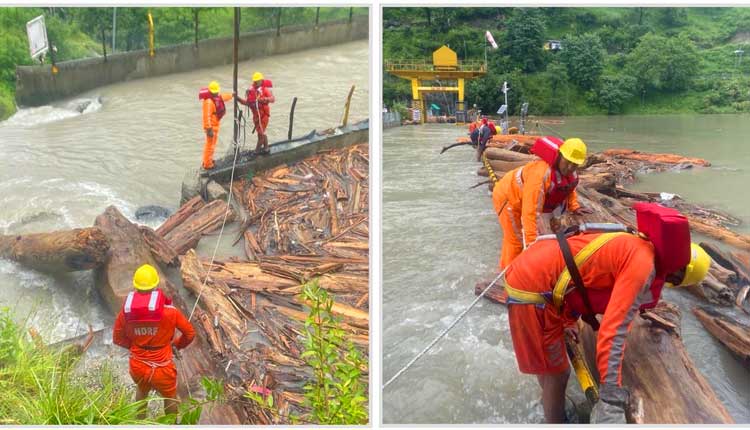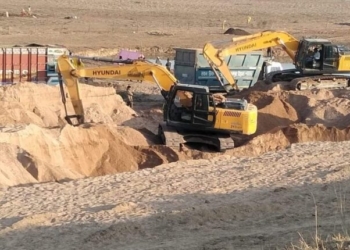Shimla: The northern state of Himachal Pradesh has been witnessing torrential monsoon rainfall, accompanying frequent cloudbursts and high-magnitude flash floods, for nearly a month now, causing massive landslides and mudslides in the hilly terrain.
An unusual phenomenon this time is the presence of large numbers of big logs, trees and roots floating in the rivers that aggravate the consequences of flood events with a high risk for engineered structures, warn experts. Local environment activists point fingers at the illegal felling of trees. Often, they blame the irreparable damage to the ecology on the construction of several tunnels for roads and hydropower projects. They say their voices have been blatantly ignored.
The gushing water is sweeping away bridges, village homes, and cars, and is causing widespread damage to the forests too. There are scary visuals of a deluge after a cloudburst sending tree logs crashing into villages and damage to shops and houses. A video shows a mudslide carrying logs rushing down from the hills due to a cloudburst in Thunag in Mandi district. Also, the colliding logs cause severe damage to bridges and other infrastructure. Similar visuals surfaced from industrial town Parwanoo located on the Chandigarh-Shimla national highway and close to Haryana’s Kalka town.
Boulders and large pieces of wood led to the jamming of the floodgates of the 100-MW Malana II hydropower facility, located on the Malana, a tributary of the Beas river. For nearly a week, the water has been overflowing the dam. Rescuers told IANS that wood and boulders’ accumulation at the floodgates exerts additional force on the dam structure, a portion of which got damaged. Currently, a team of the National Disaster Response Force (NDRF) has been deployed to open the floodgates to prevent the dam collapsing and inundating the nearby areas. According to the dam authorities, the gantry crane, which is used to open and close the gates, has developed snags. Engineers say the dam gates have been closed due to silt, muck and boulders. Efforts are being made to reduce the water level by breaking the corners of the dam. Visuals from the dam show a huge accumulation of logs along the dam. 14 NDRF Commandant Baljinder Singh is monitoring the operation to open the gates.
“The monsoon is indeed heavy this season, but humans have made the situation much worse,” remarked Ram Thakur, a resident of Manali. He said huge wooden debris, though a natural part of most rivers systems, but alarmingly high this season especially in tributaries of the Beas river is an indicator to restore and preserve the fluvial systems for prevention of wood-related hazards. A total of 184 people have died and 33 are missing since June 24, the day the monsoon hit the hill state. A total of 71 landslide and 51 flash flood incidents were reported till July 28. The total monetary loss is Rs 5,536.15 crore. The maximum deaths of 32 people were reported in Kullu district, followed by 30 in Shimla district.
Seeing the ‘free flow’ of logs in the rivers, by risking their lives villagers, with a belief of ‘one man’s loss is another man’s gain’, have been fishing timber logs by using hook and line. “The wood we are collecting can be used for repairing our houses that have been damaged in heavy rains,” remarked villager Zile Ram, who was trying to trap logs in the Parvati river in Kullu. While pointing towards the wooden debris collected on the river bank, his wife Durga Devi said, “It seems these seasoned logs belonged to a wooden house that was washed away in a flash flood. But some of these logs can be used by the panchayat for constructing the footbridge that got damaged in the flood,” she added.
The villagers are using cable barriers to trap the large wooden logs carried downstream. However, collection of wood is a punishable offence in the state. It is the property of the government. Last week, Pong dam authorities in Kangra district collected more than 1,100 logs of various tree species from the reservoir.
Smelling a scam in the thousands of wooden logs flowing in the rivers, Congress leader Kaul Singh blamed former Chief Minister and BJP leader Jairam Thakur for promoting the forest mafia in his constituency Seraj in Mandi district. He said the wooden logs belonged to the forest mafia that had illegally axed thousands of trees for laying roads during the previous BJP government’s tenure.
Former health and revenue minister Kaul Singh said several of these roads were constructed in Seraj without permission from the Forest Department. State-based environmental researcher and activist Manshi Asher told IANS that the huge flow of logs shows that there has been a landslide or erosion or even tree felling upstream. “Whether the logs belong to infrastructure or some other purpose, whether they are illegal or legal can only be ascertained by an inquiry. But the quantum and type of trees indicates that this was not a natural phenomena,” she added.
The state has a policy to allot trees, instead of timber or wood, at subsidized rates for constructing or repairing houses in villages. As per the Himachal Pradesh Forest (Timber Distribution to the Right Holders) Rules, the right holders who suffered from natural calamities like flash floods or fire are being given timber free of cost. A right holder is one who has recorded traditional rights in the forest settlement records for grant of timber for construction, repair and addition or alteration of a house for personal use.
Torrential rains, cloudbursts and flashfloods have become a regular feature in the hill state in recent years. Himachal Pradesh is a storehouse of biodiversity and is most vulnerable to climate change as the Himalayan glaciers have been retreating due to global warming.
(IANS)














